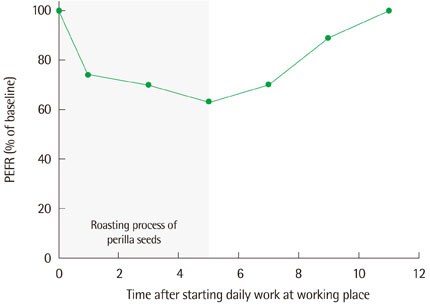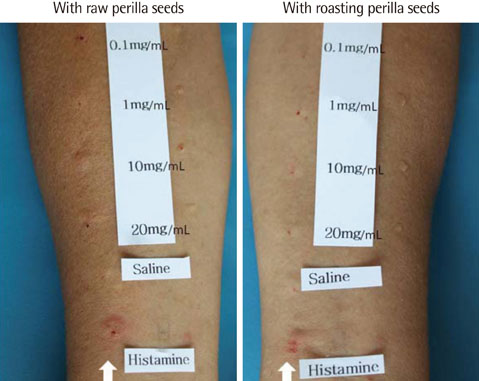Allergy Asthma Respir Dis.
2013 Mar;1(1):90-93. 10.4168/aard.2013.1.1.90.
Occupational asthma caused by inhaling smoke from roasting perilla seeds
- Affiliations
-
- 1Department of Internal Medicine, Yonsei University Wonju College of Medicine, Wonju, Korea. sanghakim@yonsei.ac.kr
- KMID: 2263066
- DOI: http://doi.org/10.4168/aard.2013.1.1.90
Abstract
- Perilla is an Asian grain that consumed for food ingredient, oil crops, medicinal materials through the process of roasting. A 49-year-old male has been roasting grains for 10 years, who met with shortness of breath during the roasting perilla seeds, but not in other situations. Serum total immunoglobulin E (IgE) level, serum eosinophil count and skin prick test didn't showed significant results. Methacholine bronchial provocation test was positive (PC20 0.31 mg/mL). Specific bronchial provocation test with inhaling smoke from roasting perilla seeds showed a dual asthmatic response. Measured peak expiratory flow rate on his work place showed the result of 37% decrease at the end of work and full recovery at 6 hours after the end of work. Skin prick test to row perilla showed positive response with late symptoms. We diagnosed that the patient had an occupational asthma caused by inhaling smoke from roasting perilla seeds with IgE mediated mechanism.
Keyword
MeSH Terms
-
Asian Continental Ancestry Group
Asthma, Occupational
Bronchial Provocation Tests
Edible Grain
Dyspnea
Eosinophils
Humans
Hypogonadism
Immunoglobulin E
Immunoglobulins
Inhalation
Male
Methacholine Chloride
Mitochondrial Diseases
Ophthalmoplegia
Peak Expiratory Flow Rate
Perilla
Seeds
Skin
Smoke
Workplace
Hypogonadism
Immunoglobulin E
Immunoglobulins
Methacholine Chloride
Mitochondrial Diseases
Ophthalmoplegia
Smoke
Figure
Reference
-
1. Bardana EJ Jr. 10. Occupational asthma. J Allergy Clin Immunol. 2008. 121:2 Suppl. S408–S411.2. Malo JL, Chan-Yeung M. Agents causing occupational asthma. J Allergy Clin Immunol. 2009. 123:545–550.
Article3. Park MH, Seol NG, Chang PS, Yoon SH, Lee JH. Effects of roasting conditions on the physicochemical properties and volatile distribution in perilla oils (Perilla frutescens var. japonica). J Food Sci. 2011. 76:C808–C816.4. Okamoto M, Mitsunobu F, Ashida K, Mifune T, Hosaki Y, Tsugeno H, et al. Effects of perilla seed oil supplementation on leukotriene generation by leucocytes in patients with asthma associated with lipometabolism. Int Arch Allergy Immunol. 2000. 122:137–142.
Article5. Kanzaki T, Kimura S. Occupational allergic contact dermatitis from perilla frutescens (shiso). Contact Dermatitis. 1992. 26:55–56.
Article6. Min SY, Park JY, Yoon JY, Hong SG, Kim DH, Kim HM, et al. A case of perilla seeds-induced anaphylaxis. Korean J Asthma Allergy Clin Immunol. 2006. 26:94–97.7. Jeong YY, Park HS, Choi JH, Kim SH, Min KU. Two cases of anaphylaxis caused by perilla seed. J Allergy Clin Immunol. 2006. 117:1505–1506.
Article8. Song JE, Lee JR, Park YH, Hong JY, Son SM, Kim KW, et al. A case of perilla allergy in a 2-year-old boy. Pediatr Allergy Respir Dis. 2009. 19:78–83.9. Mapp CE. Agents, old and new, causing occupational asthma. Occup Environ Med. 2001. 58:354–360.
Article10. Walusiak J, Wiszniewska M, Krawczyk-Adamus P, Pałczynski C. Occupational allergy to wheat flour. Nasal response to specific inhalative challenge in asthma and rhinitis vs. isolated rhinitis: a comparative study. Int J Occup Med Environ Health. 2004. 17:433–440.11. Letran A, Palacin A, Barranco P, Salcedo G, Pascual C, Quirce S. Rye flour allergens: an emerging role in baker's asthma. Am J Ind Med. 2008. 51:324–328.
Article12. Bush RK, Schroeckenstein D, Meier-Davis S, Balmes J, Rempel D. Soybean flour asthma: detection of allergens by immunoblotting. J Allergy Clin Immunol. 1988. 82:251–255.
Article13. Malo JL, Lemiere C, Desjardins A, Cartier A. Prevalence and intensity of rhinoconjunctivitis in subjects with occupational asthma. Eur Respir J. 1997. 10:1513–1515.
Article14. Talini D, Novelli F, Bacci E, Dente FL, De Santis M, Di Franco A, et al. Comparison between Airway Responses to High versus Low Molecular Weight Compounds in Occupational Asthma. J Allergy (Cairo). 2011. 2011:781470.
Article15. Cowl CT. Occupational asthma: review of assessment, treatment, and compensation. Chest. 2011. 139:674–681.16. Cockcroft DW, Hargreave FE, O'Byrne PM, Boulet LP. Understanding allergic asthma from allergen inhalation tests. Can Respir J. 2007. 14:414–418.
Article17. Armentia A, Rodriguez R, Callejo A, Martin-Esteban M, Martin-Santos JM, Salcedo G, et al. Allergy after ingestion or inhalation of cereals involves similar allergens in different ages. Clin Exp Allergy. 2002. 32:1216–1222.
Article18. Choi SH, Rha YH. Food allergy in children. J Korean Med Assoc. 2009. 52:1090–1099.
Article




